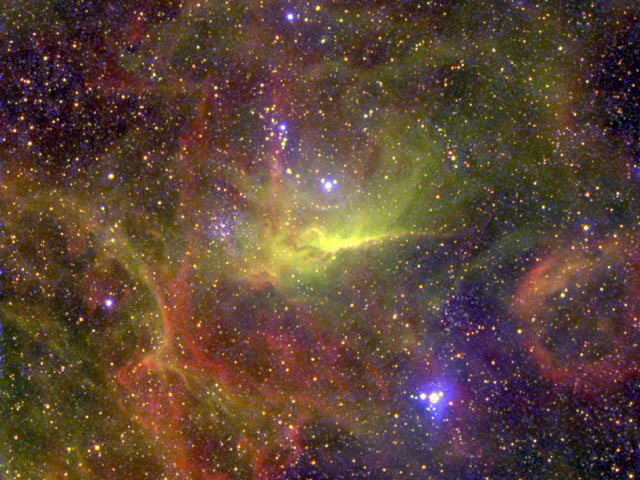Credit & Copyright: Y. Naze, G. Rauw, J. Manfroid, J. Vreux
(Univ. Liege),
Y. Chu (Univ. Illinois),
ESO
Explanation:
How could two young stars power these colorful interstellar gas clouds?
Although hidden by thick
dust, the stars spew forceful
ions and energetic
radiation that cause the clouds to fragment and light up.
The above composite color image from the
European Southern Observatory's
Melipal
VLT telescope resolves details in the
nebula complex known as BAT99-49, with emission from
helium atoms in blue hues,
oxygen atoms in green, and
hydrogen atoms in red.
Located in the
Large Magellanic Cloud (LMC), the largest
satellite galaxy to our own
Milky Way Galaxy, one of the stars in the central
binary is an enigmatic
Wolf-Rayet star
while the other is a massive
O star.
Wolf-Rayet stars have some of the
hottest surfaces in the universe, while O stars are the most
massive and energetic of normal main sequence stars.
1999 2000 2001 2002 2003 2004 2005 2006 2007 2008 2009 2010 2011 2012 2013 2014 2015 2016 2017 2018 2019 2020 2021 2022 2023 2024 2025 |
Yanvar' Fevral' Mart Aprel' Mai Iyun' Iyul' Avgust Sentyabr' Oktyabr' Noyabr' Dekabr' |
NASA Web Site Statements, Warnings, and Disclaimers
NASA Official: Jay Norris. Specific rights apply.
A service of: LHEA at NASA / GSFC
& Michigan Tech. U.
|
Publikacii s klyuchevymi slovami:
Wolf-Rayet star - binary star - zvezdy Vol'fa-Raie - dvoinye zvezdy
Publikacii so slovami: Wolf-Rayet star - binary star - zvezdy Vol'fa-Raie - dvoinye zvezdy | |
Sm. takzhe:
Vse publikacii na tu zhe temu >> | |
